The meaning of photography, or, B(latent) horror effects (1)

Installation view of “Lieko Shiga: Rasen Kaigan.” Photo Lieko Shiga, courtesy Sendai Mediatheque
Photographs are endowed with both a certain physical substantivity, to the extent that they are “traces” left by light on photosensitive material or light-receiving elements, and a fundamental openness in that one cannot determine unequivocally from the photograph alone what the traces are traces of (ie, what the photograph captures). On account of this essence of being at once substantive and open, photographs induce an abundance of words seeking to establish and identify their meaning. Photography is defenseless against such words, and yet regardless of the volume of such words that are mobilized against it, (1) this astonishing openness is never filled. For this reason, discourse that seeks to substitute photography with explanatory notes regarding the personal circumstances of the creator or the context surrounding the subject, or expound philosophical thought about photography, having raised it to the status of “the unspeakable” (2), is nothing but idle chatter, revealing nothing about photography itself.
Aside from the obvious fact that their absence is no loss (they are praised by no one) and their presence no harm (neither does anyone criticize them), the reason why the majority of the explanatory notes published in photo books and exhibition catalogs consist of nothing but this kind of chatter, which is to say chatter that never reaches the heights of criticism, is that to start with the number of people who observe closely the photographs (plural!) themselves rather than reading the introductions or explanatory notes, or in other words the number of people who take note of vertical positions, horizontal positions, square formats, front light, back light, photometry, close-ups, telephotography, focus, blur, printing, visual angle, composition, sequence, installation, layout, book design, etc, is incredibly small. Viewing Lieko Shiga’s exhibition “Rasen Kaigan” at Sendai Mediatheque and reading the lecture notes and reviews of the exhibition in various media, it is this that I became conscious of once again. “Rasen Kaigan” is a well-produced exhibition, but it achieves this in spite of the pretentious “chatter” of the many commentators who make no effort to base their contributions on the photographs themselves.
Essentially, like (instrumental) music, photography is meaningless. And just as the tone deaf try to understand music by giving it titles such as “Fate” and “Revolution,” those unable to understand photography flock around captions such as “Great earthquake” and “radioactive contamination.” However, while anyone who responded to hearing Beethoven’s Symphony no. 5 by claiming to have really heard “fate knocking at the door” would be laughed away, in contrast to this, anyone who saw a photograph of a seemingly peaceful rural scene only to be informed, “But actually it’s land rendered uninhabitable by the Fukushima nuclear accident,” and wasn’t touched (“Really? But it’s a dull photograph, isn’t it.”) would be willfully ignored. Some might argue that we would be right to ignore them, because whereas the “Fate” moniker stems from a later episode that had nothing to do with the composer himself, areas affected by radioactive contamination actually exist. However, “actual radioactive contamination” is not depicted in the photograph itself, and to the extent that one cannot ascertain the true circumstances from the photograph itself, the “But actually…” part is surely an episode that derives from outside the photograph itself. Or so one might argue.
“But actually…” is none other than the formula of surrealism. According to this formula, the reality that meets our eyes (the real) is not everything, and there is actually another reality invisible to the naked eye (the surreal) behind it. Seen in this light, photography becomes a medium that reveals the true condition of the world that cannot be seen with the naked eye, clouded as it is by everyday life. Or in other words, because photographs are substantive traces of the real world, they depict the surreal reality that is invisible and therefore beyond the bounds of preconceived notions. In this way, the surrealists remedied for the time being the dichotomy of substantivity and undecidability that lies at the heart of photography. (3)
According to the surrealists, then, photographs capture something invisible, something that cannot be clearly identified. However, for a simple photograph of a Parisian street corner to look like a “crime scene,” which is to say for a simple photograph to imply “something invisible,” it ought to hint in some form or another that there is “something” there. In fact, to persuade us that there is some kind of meaning there that a photograph would not normally be able to take on, it would be quicker if “the invisible something” were printed on the photograph in a form more direct than a hint. And so there emerged a genre of photography that developed and made full use of a range of effects. The prototypes for these photographs that hint at or depict invisible things – spirits (floating spirits, earthbound spirits), maliciousness (residual psychic energy, murder scenes, defiled ground), ectoplasm (ethereal bodies), UFOs (aliens) – are psychic photographs and horror movies.
One could call horror movies a form-based genre focused not on story but on various frightening effects, or in other words the suggestion and expression of “something invisible.” Horror fans are people who enjoy (ie, find so frightening they smile between sobs) bloodcurdling effects as pure form. On the Internet, images brimful of frightening effects (both original work and work by others in the style of The Exorcist, The X-Files and so on) are referred to by such fans as “creepy photography” and comprise their own genre. To give readers an idea of the kinds of things that exist as pure effects, below are some examples of the kinds of images, excluding those of darkness, blood, dead bodies, and skeletons, that form the mainstay of the horror genre, that result from an image search using the keywords “creepy photography.”
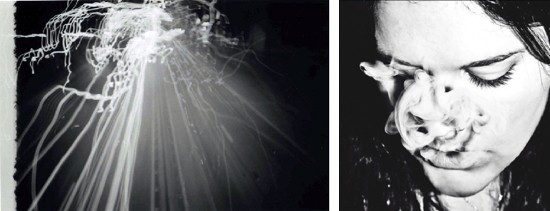
Streaming light, water, etc. (ectoplasm, ethereal bodies, mysterious light, blood, liquid, etc)
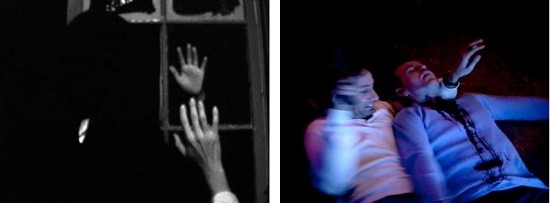
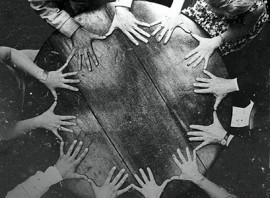
Partial bodies (severed hands, body parts protruding from inconceivable locations)
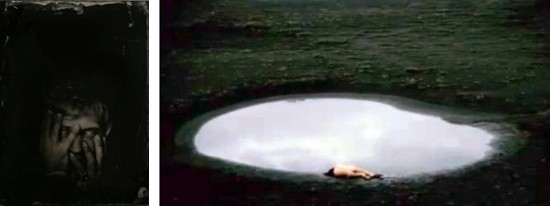
Left: Emerging from darkness (the effect of obscuring the totality). Right: Unidentified objects, dead bodies (aliens)
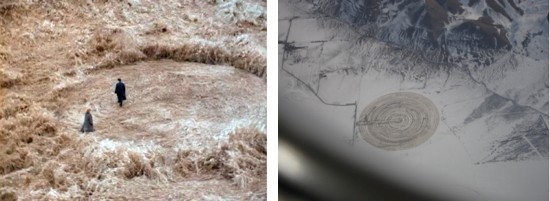
Crop circles (geometric patterns in natural settings)

Levitation
We call horror that consists of nothing but the formal repetition of such effects B (blatant; B-grade) horror. (4) As I am sure readers themselves already suspect, Lieko Shiga’s photographs are B-grade horror. Or rather, so laughably blatant is this that I have come to believe that this is the reason why Lieko Shiga’s photographs are so popular. (To be continued)
-
Descriptions of the subjects; descriptions of the process leading up to the production, the methods used in shooting, developing and processing; the creator’s thoughts on collaboration with the subject, fieldwork on location, their theory of photography, thoughts on the photographic industry, creators that inspired them, etc. For as long as they like, for as much as they like, bypassing the actual photographs.
- Variations include “blindness,” “void,” “death,” etc.
- One of the results of this remedying was the “documentary” genre. Accordingly, it is natural for people to resist relinquishing the position that “Rasen Kaigan” is almost a disaster area documentary while at the same time arguing with increasing vehemence that it is not a work of documentary. To put it another way, psychic photography and horror movies represent surrealism and documentaries in their democratized/popularized form.
- Which perhaps then means that “A”-grade horror is movies that make us tremble with fear without employing any of these effects (although would we really call such movies horror movies?).
